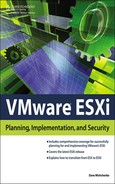VMware ESXi is the easiest way to get started with virtualization. It has been steadily growing in popularity since it was released in the free VMware vSphere Hypervisor edition. As part of the vSphere family, it can be licensed at the same levels as VMware ESX and provides the same functionality that you’re accustomed to with ESX.
With the release of vSphere 4.1, VMware has stated that there will be no future releases of ESX. VMware ESXi is now the flagship hypervisor for the vSphere product family. This book will cover installation, management, security, and integration of ESXi into your current environment to provide a seamless migration from ESX to ESXi.
This book is targeted to current VMware VI3 and vSphere administrators who may be planning their migration to vSphere ESXi. These users may have some experience with ESXi but not yet have it deployed within their production environment. This book provides the guidance to implement ESXi in their environment, ensuring a smooth transition from their current deployment of ESX.
This book covers the following aspects of migrating a VI3 or vSphere ESX environment to vSphere ESXi:
Chapter 1, “Introduction to VMware ESXi 4.1,” provides an introduction to VMware ESXi, including some of the aspects of managing ESXi, comparing it with ESX, and new features in ESXi 4.1.
Chapter 2, “Getting Started with a Quick Install,” reviews the hardware requirements for ESXi, walks through an interactive installation, and outlines post-installation tasks to perform.
Chapter 3, “Management Tools,” reviews the management tools available for ESXi. These tools include the vSphere client, vCenter Server, the vSphere command-line interface (vCLI), PowerCLI, the Direct Console User Interface (DCUI), and a few other tools.
Chapter 4, “Installation Options,” discusses the installation options for ESXi. VMware ESXi is available in both an Embedded edition and an Installable edition. New for ESXi 4.1 is the option to perform scripted installations.
Chapter 5, “Migrating from ESX,” covers migration options from your current environment to vCenter Server 4.1 and ESXi 4.1. You’ll read about the various steps for upgrading vCenter Server, your vSphere hosts, and virtual machines in this chapter.
Chapter 6, “System Monitoring and Management,” introduces various aspects of system monitoring and management. New for ESXi 4.1 is Active Directory integration. The chapter also includes configuring vCenter alarms, performance charts, storage views, and host backup.
Chapter 7, “Securing ESXi,” discusses the various aspects of securing your ESXi hosts. This includes coverage of the architecture and security features of ESXi, protecting your ESXi hosts and virtual machines, and configuring authentication for your hosts.
Chapter 8, “Scripting and Automation with the vCLI,” talks about the vCLI. The vCLI was released as the Remote Command-Line Interface (RCLI) and is a replacement mechanism for administrators accustomed to using the Service Console on ESX.
Chapter 9, “Scripting and Automation with PowerCLI,” covers VMware PowerCLI. PowerCLI is a VMware extension to Microsoft PowerShell that allows you to automate all aspects of managing your vSphere environment.
Chapter 10, “Patching and Updating ESXi,” discusses various aspects of patching and upgrading ESXi hosts. VMware ESXi can be patched with a number of tools including the vCLI, PowerCLI, and vCenter Update Manager.
Chapter 11, “Under the Hood with the ESXi Tech Support Mode,” introduces ESXi Tech Support Mode (TSM). TSM provides direct access to the VMkernel of ESXi and is used for advanced configuration tasks and troubleshooting.
Note
The scripts used in this book are available for download from http://www.vm-help.com/esxi_book.zip and http://www.courseptr.com/downloads.
